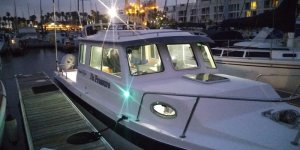pcg":1ysgcb50 said:
ssobol":1ysgcb50 said:
I added LED sign modules to light the interiors of the main cabin cabinets and the storage areas under the berth.
What are LED "sign modules"?
ssobol":1ysgcb50 said:
The red light protecting night vision may be a myth. It is more about the intensity of the light than the color. Also, red illumination can make red/magenta markings on charts disappear. Considering that these markings on charts typically mark important or dangerous areas, not being able to see them could be a problem.
Interesting, good point. Thanks.
This is technically correct. However, trying to keep a small boat a 1 CP is difficult. I use a flashlight every night, at 1 CP--red or white--one button takes it t0 30, 60, 300 and 900 as you wish. When I am checking pills, I use 1 CP white, for walking and seeing my way, 1 CP red.
The eye does adapt to the low 1cp white better than 1 cp red. Note that many us Navy ships still use red (some aircraft use red, some blue and some white.
The reason I use red, is that it is easier to get the low light LED (measured with Sikonic meter that I use for photography) in red than in white. I always had a very low intensity flashlight at the navigation station when cruising before LED. We did also use red bulbs or filters at that time. (Yes one can say that certain light meters respond differently to red spectrum vs white spectrum).
I do what works for me, and no accident turning on the white light vs red low level lights.
The question I ask is why so many US Navy and Merchant ship night collusions in the last few years? Just should not happen with Radar, AIS, and good night vision scopes etc.
Also having been surrounded by a US Navy Carrier fleet running totally dark, except carrier landing lights occasionally seen , about 200 miles off shore, is a most disturbing. The navy ("This is the captain of the USNS Coral Sea") responded after I expressed concern to CG sector San Diego via Marine SSB HF,
Perhaps even worse, is a US Coast Guard cutter coming up form behind at over 20 knots running totally dark in mid Caribbean, and not responding to VHF on 16. (I called sector Miami on Marine HF frequencies and explained I was about ready to break out arms and prepare to fire--a warning I had already given on VHF,16.)--after the Call to Miami about 2 minutes later CG cutter came on VHF and turned on lights--by that time they are only about 400 yards away.

